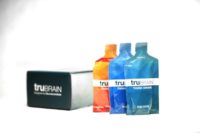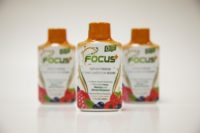Whether it’s from your family physician or it’s used as a tag line in a national commercial, many consumers have heard the phrase, “You are what you eat.” And with The Journal of the American Medical Association reporting earlier this year in its article “Prevalence of Childhood and Adult Obesity in the United States, 2011-2012” that more than one-third of adults and 17 percent of adolescents are considered obese, consumers might be looking for more ways to reignite their healthy lifestyles.
In New York-based Nielsen’s August report “Health & Wellness in America,” the market research firm cited longitudinal consumer data from the National Marketing Institute (NMI) that nearly one-third of American adults think that functional foods and beverages can be used to supplement some medicines to support their overall health and wellness. This is up from 26 percent in 2008, the market research firm reports.
With consumers increasingly finding favor with fortified products, Nielsen anticipates this could allow for more opportunities for consumer packaged goods (CPG) manufacturers. “The fortified and functional food and beverage category has significant opportunities to expand in two major ways,” the report states. “First, the category can expand by creating new product formats that incorporate more traditional but necessary daily nutrients, such as calcium and fiber. Second, it can expand via fortification opportunities using emerging nutrients such as phytosterols and probiotics, which are more difficult to obtain in a typical American diet.”
Fortified liquid
In the beverage industry, brand owners are no stranger to fortification. However, the formats and ingredients used have evolved over the years.
Barbara Heidolph, director of commercial and applications development with Cranbury, N.J.-based Innophos Inc., explains that when it comes to fortification and beverages, sports drinks featuring potassium have been the primary product for fortification for years. She adds that beverage manufacturers, though, more recently have taken beverage fortification a step further.
“Beverages are being used as a way to deliver essential vitamins and minerals in a convenient and enjoyable format,” Heidolph says. “Each beverage may have other functions, such as refreshment or a quick meal, but the primary reason for delivering the fortification is that consumers demand it.”
Kristine Sanschagrin, marketing manager of specialty seeds and oil for Minneapolis-based Cargill, echoes similar sentiments. “The trend toward health and wellbeing is growing rapidly, and it’s affecting all food and beverage categories,” she says. “Consumers are avoiding certain ingredients and seeking out products with added benefits such as fiber, protein and omega-3s. In our proprietary Opportunity Optimizer consumer research [that was] conducted earlier this year, we found that 77 percent of consumers see nutrition as the third-most important driver [for purchase], after taste and value for the money.”
Elsie Jamin-Maguire, business manager of food and beverages for BASF Nutrition & Health, Florham Park, N.J., explains that as consumer interest in fortified beverages increases, beverage-makers are using vitamins and minerals to meet this demand and fulfill popular functional claims. “The top claims that we are seeing for beverages include those related to the immune system, brain and nervous system, heart and weight management,” she says.
Russ Hazen, premix innovation manager for Fortitech Premixes of North America, Schenectady, N.Y., notes that demographics have driven the condition-specific market. “With boomers being the largest single consumer demographic, this group embraces the concept of healthy aging and is interested in products that address a myriad of issues such as cardiovascular health, bone and joint health, cognitive function, energy, [and] weight and blood sugar management, just to name a few,” he says.
In Nielsen’s “Health & Wellness in America” report, it states that the baby boomer generation — those born between 1946 and 1964 — control more than 70 percent of U.S. disposable income and drive much of the demand for these better-for-you products. The report also notes that millennials express interest in nutrient-enriched products.
Fortitech’s Hazen also emphasizes that although baby boomers and millennials are influencing much of the beverage fortification market, it is not the only interested demographic. “Overall, I think consumers are just more in tune with the link between nutrition and their overall health and wellness,” he says. “Virtually every demographic is aware of the importance of doing whatever they can to maintain optimum health. Whether it’s the mom concerned about something like immunity for her children or an athlete looking to optimize [his or her] performance, consumers are actively looking to specific nutrients to enhance their wellbeing.”
Supporting the function
Because of the increased acceptance of fortified foods and beverages, the market for fortification within beverages has increased, experts note.
“This market will continue to grow as consumers look for great-tasting beverages that deliver superior nutrition and provide hydration along with nutrients in sports drinks, meal replacement beverages and enhanced waters,” BASF’s Jamin-Maguire says.
Among the collection of ingredients supporting function-based beverages are B vitamins, Jamin-Maguire notes. “B vitamins win the popularity contest when it comes to beverages, especially in energy drinks,” she says. “Those include B3, B5 and B6, with B12 being the most commonly added. B vitamins are relatively easy to work with and are water soluble.”
Vitamins A, E and D have gained steam, BASF’s Jamin-Maguire says. For instance, vitamin D has benefited from science-backed research supporting the ingredient, she adds. “Together these vitamins provide a broad range of health benefits, and consumers are becoming increasingly aware that their typical daily diets fall short in getting the required amounts of each vitamin,” Jamin-Maguire explains.
In particular, vitamin K has been finding an increasing presence in bone- and heart-health products, Fortitech’s Hazen says. He adds that most formulation has been in the form of modifications to the format of the nutrient, but advancements are helping to support vitamin K and other vitamins to increase their beverage presence.
“New technologies are allowing many fat-soluble vitamins like A, E, D and K to be incorporated into beverage products by increasing their ability to disperse in an aqueous product matrix through the use of microencapsulation or nanoemulsions,” Hazen explains. “These same technologies provide functional attributes and increase consumer acceptance of fortified products.”
Innophos’ Heidolph adds that minerals such as calcium and potassium continue to be common choices for beverage fortification. “Calcium has always been in focus,” she says. “Calcium helps to support bone health as well as cardiovascular health. Potassium has been part of sports formulations for years. But the fact is that potassium is now recognized by all as a nutrient that is not consumed in sufficient quantity.
“Potassium is known to be an antidote to sodium,” she continues. “Some nutritionists believe that sodium reduction is not required if sufficient potassium is consumed. Potassium is also critical for maintaining water balance in the body and aids in conductivity of the nervous system.”
Another mineral that might begin to gain traction — possibly in the 2015 Dietary Guidelines for Americans — is magnesium, Heidolph says. “Most of the population does not consume sufficient magnesium,” she says. “Magnesium deficiency has been noted in a number of health issues. Sufficient magnesium intake may promote muscle function, promote bone health, enhance protein synthesis, and reduce fatigue and tiredness.”
To help support mineral fortification, Innophos has designed mineral-based ingredients in formats that support beverage formulation, Heidolph notes. For calcium, it offers its VersaCAL Clear for clear beverages. “This ingredient delivers approximately 15 percent calcium in a soluble format that does not impact taste,” she explains.
Beyond vitamins and minerals, beverage-makers also are turning to other ingredients to support the better-for-you market. “Adding omega-3 fatty acids is a regular request that we receive,” Fortitech’s Hazen says. “It is also common to see the protein content of these beverages increase with the addition of protein concentrate or isolate that could be whey based or, as is becoming more common, a combination of dairy and vegetable proteins.”
Cargill’s Sanschagrin also notes the increased traction that omega-3s are gaining in the beverage market. “Consumers are increasingly aware of the benefits of EPA/DHA omega-3s,” she says. “However, in the past, many beverage manufacturers were reluctant to add omega-3s due to difficulty with storage and handling, off-flavors, and the high cost per serving.”
To resolve some of these issues, Cargill introduced IngreVita in June. “IngreVita offers beverage-makers a shelf-stable, sensory-neutral, low-cost, easy-to-use ingredient that can help them boost the nutritional benefits of their products,” Sanschagrin says.
The beverage ingredient features a blend of high oleic canola oil, fish oil and propriety antioxidants to support heart health and brain development, she adds.
Given the vast number of nutrients that are available to beverage-makers, ingredient suppliers recognize the need to develop formulations that support a wide range functions. For instance, during the 2014 IFT Annual Meeting & Food Expo, Glanbia Nutritionals, Evanston, Ill., offered samples of an Energy Chia Smoothie featuring ALA omega-3, BevGrad chia, NutraShield caffeine, Carnipure Carnitine for energy, Chromax Chromium Picolinate for cognitive support, and B vitamins for natural energy.
Through its premixes, Fortitech also is working with more than 1,400 nutrients from around the world, Hazen notes. “Our mantra, so to speak, is any nutrient in any application,” he says. The company also has access to its the Netherlands-based parent company’s, Royal DSM, portfolio of ingredients including Fabuless for Satiety, OatWell Oat Beta-Glucan, FloraGLO Lutein and Optisharp Zeaxanthin, Hazen adds.









